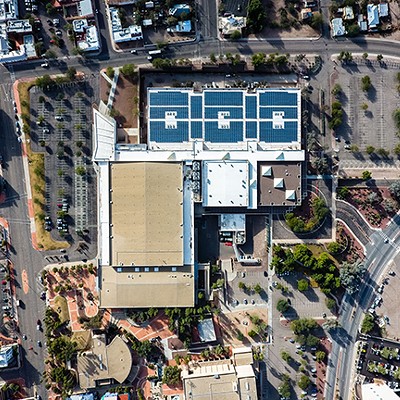After serving on the base and then being a 14-year civilian employee at its airplane storage "boneyard," Callahan worked for Raytheon. With an eye toward retirement, he and his wife paid $125,000 for 10 acres of industrially zoned vacant land in Rita Ranch on the city's southeast side a decade ago. They hoped to improve and sell the Rita Road site, which is near a residential area, using the profits as a major part of their retirement account.
"I'm not a developer or builder," the 56-year old Callahan emphasizes. "I thought I could bring in some service-type uses for the Rita Ranch community. I wasn't going to put in something (industrial)."
Spending almost $200,000 to subdivide the land into eight lots and install a roadway and other infrastructure, Callahan sold two parcels for $205,000. Near a Domino's Pizza restaurant and Tucson Medical Center clinic now stands a wooden sign, its cracked white paint announcing the remaining lots for sale.
Several years ago, while Callahan was hoping to sell his land, the city of Tucson began considering more restrictive zoning regulations around Davis-Monthan. Impacting not only nearby property owners to the northwest of the base (See "Fight Over Over-Flights," Nov. 18, 2004), they would also affect Callahan's land, even though it sits five miles away from the D-M runway.
The new zoning regulations overlaying Callahan's property were permanently adopted by the City Council in October and are intended to limit the number of employees under the D-M flight path to no more than 20 per acre. Since military aircraft taking off to the southeast sometimes carry bombs, that had to be considered.
"We wanted to avoid uses which draw people in higher concentrations into the area, like churches, offices and restaurants," says Sarah More, of the Tucson Planning Department. "It's a very restrictive zoning category."
In addition to Callahan's land, 176 other properties were impacted, including the two immediately adjoining his--the CrossPoint Community Church and 20 acres of mostly vacant industrially zoned land.
"We've had our market chopped in half (by the regulations)," complains Buddy Eagerton, the real estate representative for the latter property. "They've eliminated 80 to 90 percent of our calls of interest. While the property taxes are skyrocketing, the value of the land has gone down."
Before adoption of the new regulations, the church had a master plan prepared, intending to substantially expand. According to pastor Jim Corley, that proposal was shelved. "We're no longer allowed to develop any of the uses shown on the master plan," he says.
The new restrictions also eliminated almost all of the uses Callahan envisioned for his property. "Junkyards and uses like that are the only ones I have left," he shrugs. "They took away the good ones, and left me with the costume jewelry."
Enforcement of the regulations also concerns Callahan. He points to the nearby University of Arizona Science and Technology Park, which is just outside the city limits, and the abandoned Slim-Fast facility.
Planner More replies the Slim-Fast building is on a large site and had few employees before it shut down. In addition to its enormous land area, More indicates, the research and development uses in the Tech Park "are sort of grandfathered" by the regulations, which Pima County has yet to adopt anyway. If any commercial tenants are proposed for the site, and the park is annexed into the city, More concedes she doesn't know how that issue would be handled.
Once the new zoning was in place, Callahan hired a lawyer and turned to the city's Board of Adjustment for relief. He argued his desire to sell the land for commercial uses should be allowed, since he had already made improvements to the property. When they met in January, the board agreed with Callahan. But afraid of the possible precedent-setting ramifications of this vote, the city appealed the decision, and the board reversed itself in March.
After almost $15,000 in attorney fees, Callahan can't afford to continue the legal fight. "With each meeting, my wallet was getting thinner," he says. "I'm losing valuable uses for the land along with my savings. Everything I worked 38 years for has been significantly reduced."
More admits she feels sorry for Callahan. "We knew some things like this were going to happen, which are not good," she says of the land use regulations. "It would be best if he were bought out (by the government)."
That prospect doesn't appear likely. Pima County does have $10 million in 2004 open-space-bond funds available for land purchases around D-M, but existing uses like the church will probably have higher priority than Callahan's vacant land.
Since the church capacity is around 200 and its day care center serves 120, pastor Corley says: "Because there are so many here, the government doesn't want us here."
Calling Callahan's situation "tragic," Corley adds: "If safety (from over-flights) is the real issue, driving through the intersection of Kolb and Valencia (roads) is more risky."
As local leaders await the anticipated May 13 release of the Pentagon's suggestions for military base closures, a list D-M will almost certainly not be on, Callahan remains upset at what has happened to him.
"I did everything I could to be a good neighbor," he says in frustration, "but in the end I took it in the shorts."












